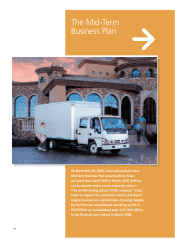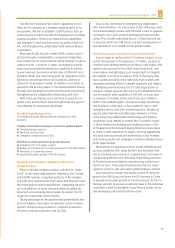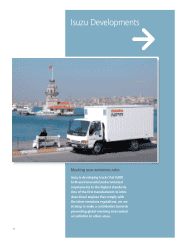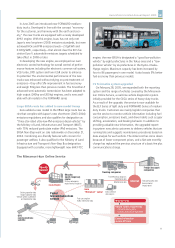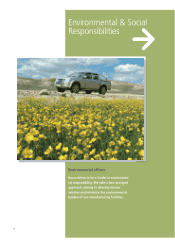Isuzu 2005 Annual Report Download - page 17
Download and view the complete annual report
Please find page 17 of the 2005 Isuzu annual report below. You can navigate through the pages in the report by either clicking on the pages listed below, or by using the keyword search tool below to find specific information within the annual report.
18
«
Isuzu Motors Limited Annual Report 2005
FINANCIAL SECTION
Net Profit
In fiscal 2005 our net profit was ¥60,037 million, an increase of ¥5,324 mil-
lion from the prior year. Earnings per share came to ¥56.64 and fully diluted
earnings per share to ¥25.79.
Segment information
Japan
In Japan, there was a reactionary decline in overall demand after a sharp in-
crease in the previous fiscal year due to the introduction of stricter diesel emis-
sions rules. Nonetheless, domestic sales increased 2.1% from a year earlier to
¥1,087,862 million because of strong growth in export sales. However operat-
ing profit declined 5.5% to ¥72,931 million, despite sustained streamlining and
fixed expense reduction efforts undertaken under our New Three-Year Business
Plan.
North America
North American sales fell 14.7% to ¥200,888 million, largely attributable to
the withdrawal from local SUV production. Our North American operating loss
narrowed from the previous year’s ¥688 million to ¥229 million despite costs
incurred by the withdrawal.
Asia
Sales in Asia surged 41.2% to ¥296,598 million chiefly due to brisk sales of
our pickup trucks in Thailand. The D-MAX pickup truck launched in May 2002
remains the best-selling vehicle ever in Thailand. Operating profit also grew
124.4% to ¥14,082 million.
Other regions
Sales in other regions grew 27.9% to ¥33,192 million as a result of marketing
activities in Australia, but operating profit fell 5.5% to ¥1,322 million.
Financial Condition
Cash Flow
In fiscal 2005 Isuzu generated net cash flow of ¥135,252 million, up ¥32,672
million from the prior year. Despite a higher net income before taxes, net cash
provided by operating activities declined ¥19,761 million from a year earlier to
¥65,531 million because of an increase in equity-level investment profit and
corporate tax payments, and temporary increase in accounts receivable pri-
marily associated with Thai manufacturing operations becoming consolidated
subsidiaries.
Net cash used in investing activities declined ¥2,127 million to ¥7,795 million.
Capital investments made mainly by the parent company and operations in the
ASEAN region were offset by ¥11,319 million of inflows from the sale of invest-
ment securities and ¥16,865 million from the sale of fixed assets.
Net cash used in financing activities declined ¥2,631 million to ¥26,366 mil-
lion. While we used cash generated by operating activities as a resource in our
continued effort to shrink liabilities, we also redeemed ¥60,000 million of class
2 preferred stock during the fiscal year. Revenue-wise we raised ¥100,000 mil-
lion for R&D and capital investment from our second unsecured convertible
bond issue. Isuzu also restructured its borrowings in February 2005 by repay-
ing all existing loans and signing a syndicated loan agreement consisting of a
¥240,000 million term loan and ¥62,000 million commitment line to secure
liquidity.
Assets
As of March 31, 2005, total consolidated assets were ¥1,142,580 million, an
increase of ¥64,763 million from a year earlier.
Main factors contributing to the increase were cash reserves, which grew
¥26,042 million from ¥113,315 million to ¥139,357 million, notes and accounts
receivable (up ¥31,810 million from ¥216,934 million to ¥248,744 million), in-
ventory (up ¥11,588 million from ¥112,938 million to ¥124,526 million), and
tangible fixed assets (up ¥9,482 million from ¥449,131 million to ¥458,613 mil-
lion). Cash reserves increased because of cash flow from operating activities re-
sulting from record profits and strengthened cash management structure, while
increases in notes and accounts receivable, inventory, and tangible fixed assets
were mainly associated with the consolidation of manufacturing operations in
Thailand.
The ¥5,118 million decline in long-term borrowings from ¥27,409 million
to ¥22,291 million is also mainly attributed to the offset and elimination of the
outstanding loan balance of newly consolidated Thai manufacturing operations
in the consolidated accounts.
Liabilities
Total liabilities increased ¥4,997 million from a year earlier to ¥969,928 mil-
lion. Interest-bearing liabilities (total of short-term borrowings, commercial pa-
per, corporate bonds with less than a year to redemption, corporate bonds, and
long-term borrowings) decreased ¥53,561 million from ¥446,664 million to
¥393,103 million.
In fiscal 2005 we concluded a syndicated loan agreement consisting of a
¥240,000 million term loan and ¥62,000 million commitment line to ensure li-
quidity after repaying all of our existing borrowings. This led to a sharp decrease
in short-term borrowings and an increase in long-term borrowings.
The balance of our second unsecured convertible bond stood at ¥56,000
million on March 31, 2005, adding ¥50,000 million to our liabilities compared
with the previous fiscal year.
Capital
In fiscal 2005, our capital grew ¥48,710 million to ¥158,463 million.
Although ¥60,000 million of class 2 preferred stock was redeemed during the
fiscal year, ¥60,037 million of net profit was generated in addition to the ex-
ercise of ¥50,000 million of convertible bonds increasing capital by the same
amount. Consequently our equity ratio improved 3.7 percentage points from a
year earlier to 13.9%.
Risks
In 2002, in response to the protracted slump in the Japanese commercial
vehicle market and lackluster SUV sales in the U.S., the Isuzu group drew up its
New Three-Year Business Plan covering the three-year period to March 2005 to
restore corporate value and strengthen corporate competitiveness.
In the interim period ended September 2002, Isuzu showed a temporary nega-
tive net worth due to the poor performance of its subsidiaries. However, thanks
to steps taken under the New Three-Year Business Plan, such as a private place-
ment of new shares and the exchange of debt for equity, the company showed
a positive net worth again in March 2003. In fiscal 2005, the final year of the
plan, we continued our efforts to strengthen business functions and shore up
our profit structure. Being well on track to achieving our goals, in November
2004 we formulated a new business plan ending in March 2008, and approved
the resumption of dividend payments at the 103rd annual general meeting of
shareholders on June 29, 2005. However, there are certain risks that could have
significant impact on our earnings results, financial condition, or share price,
and these risks are outlined below. (The following information contains for-
ward-looking statements that reflect the judgment of management as of March
31, 2005).
1. Economic situation/supply and demand trends in our major markets
Vehicles account for an important portion of the Isuzu group’s worldwide
operating revenue, and demand for these vehicles is affected by the economic
situation in the various countries and regions and markets where we sell ve-
hicles. Therefore, economic recession and an ensuing decline in demand in our
major markets—Japan, North America, and other Asian countries—could have
a negative impact on the earnings and financial position of the Isuzu group.
Price competition also entails the risk of price fluctuation for our products.
2. Interest rate fluctuations
The Isuzu group tightened its cash flow management and continues to con-
centrate on shrinking interest-bearing debt. Under the New Three-Year Business
Plan, we allocated profit from business operations and other funds to the reduc-


